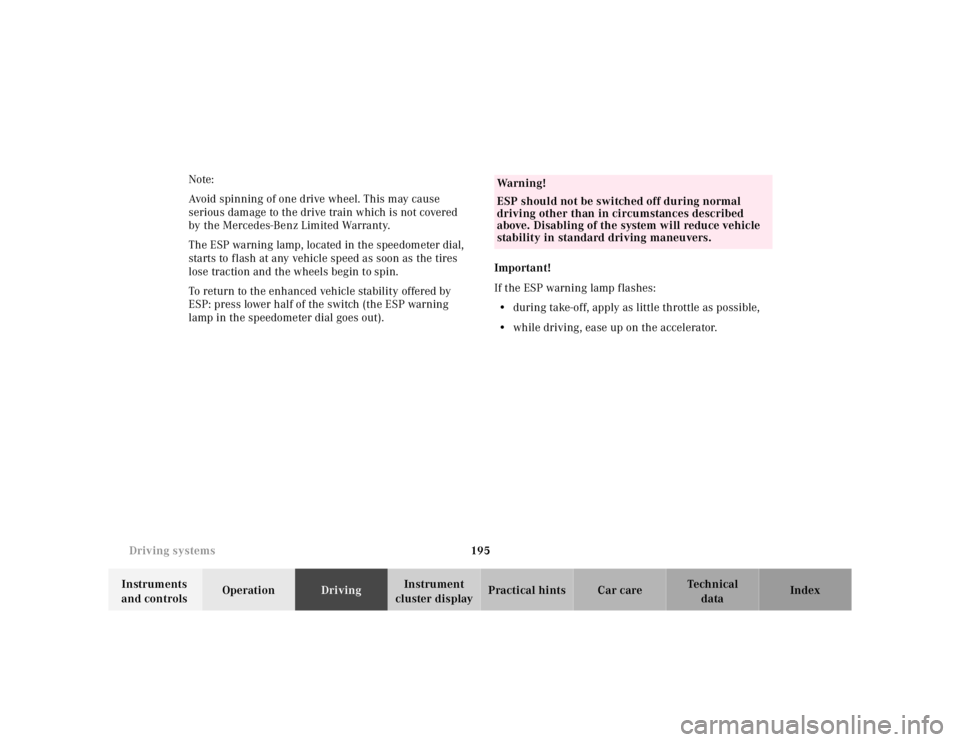traction control MERCEDES-BENZ SL CLASS 2002 User Guide
[x] Cancel search | Manufacturer: MERCEDES-BENZ, Model Year: 2002, Model line: SL CLASS, Model: MERCEDES-BENZ SL CLASS 2002Pages: 302, PDF Size: 7.05 MB
Page 198 of 302

194 Driving systems
Te ch n ica l
data Instruments
and controlsOperationDrivingInstrument
cluster displayPractical hints Car care Index
ESP control switch
ESP control switch located in center console.
To improve the vehicle’s traction when driving with
snow chains, or starting off in deep snow, sand or gravel,
switch off ESP by pressing the upper half of the ESP
switch. The ESP warning lampv, located in the
speedometer dial, is continuously illuminated.With the ESP system switched off, the engine torque
reduction feature is cancelled. Therefore, the enhanced
vehicle stability offered by ESP is unavailable.
Adapt your speed and driving to the prevailing road
conditions.
A portion of the ESP system remains active, even with
the switch in the OFF position.
If one drive wheel loses traction and begins to spin, the
brake is applied until the wheel regains sufficient
traction. The traction control engages at vehicle speeds
up to approxim ately 24 mph (40 km /h ), a nd sw itches of f
at 50 mph (80 km/h).
Wa r n i n g !
When the ESP warning lamp is illuminated
continuously, the ESP is switched off. Adapt your speed and driving to the prevailing road
conditions.
Page 199 of 302

195 Driving systems
Te ch n ica l
data Instruments
and controlsOperationDrivingInstrument
cluster displayPractical hints Car care Index Note:
Avoid spinning of one drive wheel. This may cause
serious damage to the drive train which is not covered
by the Mercedes-Benz Limited Warranty.
The ESP warning lamp, located in the speedometer dial,
starts to f lash at any vehicle speed as soon as the tires
lose traction and the wheels begin to spin.
To return to the enhanced vehicle stability offered by
ESP: press lower half of the switch (the ESP warning
lamp in the speedometer dial goes out).Important!
If the ESP warning lamp flashes:
• during take-off, apply as little throttle as possible,
• while driving, ease up on the accelerator.
Wa r n i n g !
ESP should not be switched off during normal
driving other than in circumstances described
above. Disabling of the system will reduce vehicle
stability in standard driving maneuvers.
Page 287 of 302

283 Consumer information
Te ch n ica l
data Instruments
and controlsOperation DrivingInstrument
cluster displayPractical hints Car care Index Consumer information
This has been prepared as required of all manufactures
of passenger cars under Title 49, Code of U.S. Federal
Regulations, Part 575 pursuant to the “National Traffic
and Motor Vehicle Safety Act of 1966”.
Uniform tire quality grading
Quality grades can be found where applicable on the
tire sidewall between tread shoulder and maximum
section width. For example:
All passenger car tires must conform to federal safety
requirements in addition to these grades.
Treadwear
The treadwear grade is a comparative rating based on
the wear rate of the tire when tested under controlled
conditions on a specified government test course. For
example, a tire graded 150 would wear one and one-half
(1 1/2) times as well on the government course as a tire
graded 100. The relative performance of tires depends
upon the actual conditions of their use, however, and may depart significantly from the norm due to
variations in driving habits, service practices and
differences in road characteristics and climate.
Traction
The traction grades, from highest to lowest are AA, A, B,
and C. Those grades represent the tire’s ability to stop
on wet pavement as measured under controlled
conditions on specified government test surfaces of
asphalt and concrete. A tire marked C may have poor
traction performance.
Tread wear 200 Traction AA Temperature A
Wa r n i n g !
The traction grade assigned to this tire is based on
straightahead braking traction tests, and does not
include acceleration, cornering, hydroplaning, or
peak traction characteristics.
Page 296 of 302

292 Index
Te ch n ica l
data Instruments
and controlsOperation DrivingInstrument
cluster displayPractical hints Car careIndex
Information ................................................................ 160
Initiating an emergency call ................................... 158
Roadside Assistance ................................................. 159
Telephone, general ........................................................ 132
Telephones and two-way radio ..................................... 154
The first 1 000 miles (1 500 km) ................................ 155
Tires
Driving instructions ................................................. 179
Inflation pressure .....................................................235
Replacement ..............................................................227
Speed rating ............................................................... 181
Traction ...................................................................... 180
Tow-away alarm ................................................................ 43
Tow-away protection ........................................................ 43
Towing the vehicle ......................................................... 241
Trip odometer ................................................................... 79
Trunk ................................................................................. 38
Trunk lamp .....................................................................260
Trunk lid
Emergency release ..................................................... 40
Trunk lid release switch ................................................. 39
UUnlocking the vehicle ...................................................... 30VVehicle jack ..................................................................... 218
Vehicle tools .................................................................... 217WWarranty coverage ........................................................ 270
What you should know
at the gas station ...................................................... 200
Wheels ............................................................................ 227
Changing ....................................................................231
Rotating ..................................................................... 228
Spare wheel ............................................................... 229
Tire replacement ...................................................... 227
Where to find it ................................................................ 13
Wind screen ....................................................................148
Installation .................................................................148
Removal ...................................................................... 150
Setting up ................................................................... 150